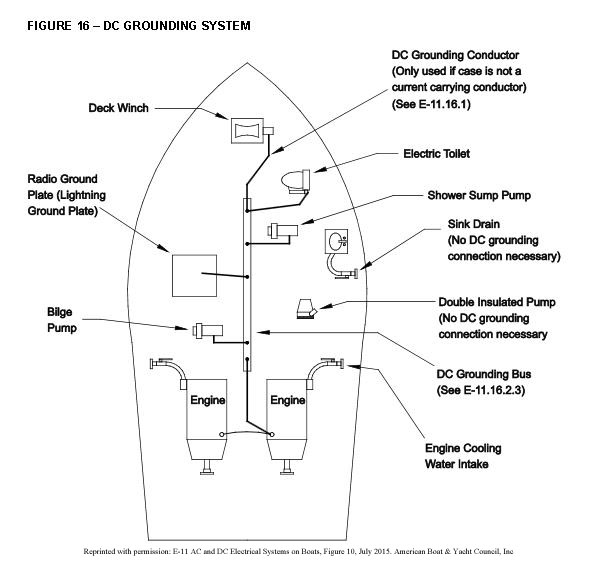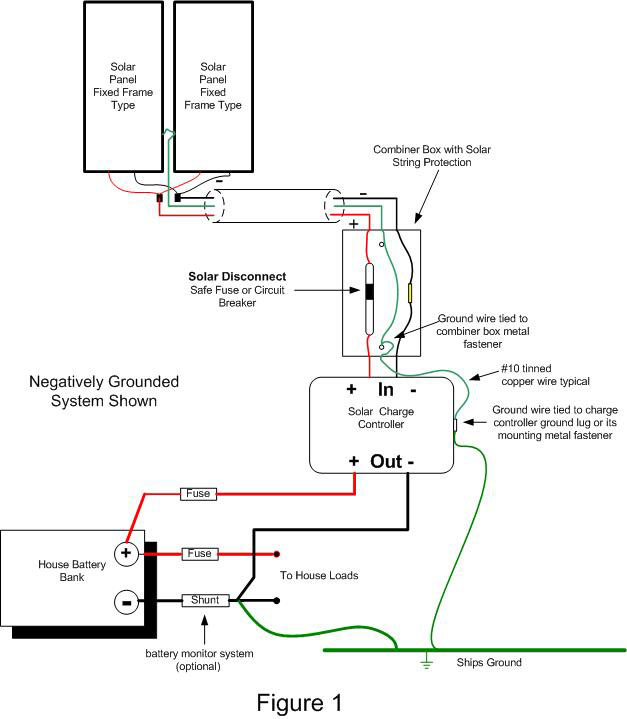Grounding Solar PV Systems on a Boat
Bonding of your solar PV to the ships ground is a critical part of a safe and reliable installation. The recommendations listed below is for informational purposes and we highly recommend any boat owner to engage with a certified marine electrician for grounding Solar PV system.
What is a ships ground?
The ships ground is a connection point whereby all the on-board equipment such as electronics, engines, generators, mounting structures, boarding ladders, masts, stays, and other metallic non-current carrying parts are connected (bonded) to a common point for the purpose of creating a current path in the event of a ground fault and also to minimize corrosion resulting from stray currents. Most boats are made of fiberglass or wood and therefore bonding to ground all of the metal items attached to the boat should exist. Unlike land-based systems where a rod can easily be driven into the ground, the boat ground point is less clear but serves the same purpose.
Typical fiberglass or wooden ships “ground point” might be an immersed ground plate, the keel (w/ exposed metal), or the engine (provided it has a non-isolated driveshaft). Unfortunately grounding systems on a boat vary significantly or may not exist at all. The ground point will connect to a DC grounding bus which is where all the bonding wires return from the equipment to be grounded.
The DC electrical system house battery negative terminal is often connected to the ships ground giving it the name “negatively grounded system”. If the positive battery terminal is connected to the ships ground, then it would be termed “positively grounded system”. See attached Figure 16 of ABYC standards which depicts a typical DC Grounding System.

Solar PV Systems - Solar PV has a higher voltage (some greater than 50 VDC) than the nominal battery voltage system (12V DC typical) on board the boat and therefore the greater the importance for equipment grounding because of the increased danger of electrical shock should there be a ground fault with the Solar PV panel or its related wiring.
Fixed Frame Solar Panels - On a system that consists of a single metal frame solar panel, connecting the ground wire from the panel directly to ships ground is needed. Always utilize the pre-drilled grounding hole located on the frame of the panel. This hole is typically clear of the frames anodizing process allowing for a good electrical connection.
On multiple metal fixed frame Solar Panels systems, the solar panel frames should be connected together with a grounding wire to each other (daisy-chained/series connected). Remember, only a single bonding wire feeds to your ships ground from the equipment (see Figure 1).

Most metal frame solar PV panels are mounted to a metal structure for support. The metal structures should already be bonded (connected) to the ships ground. Do not duplicate grounding the panel and the structure if the solar PV panels are mechanically connected to the metal frame. An additional bond wire can be added between the solar panel and the metal frame to assure an electrical connection but care should be taken to make sure that there is only one return path to the ships ground.
Many of the mounting clamps used for mechanically securing the Solar PV panels to the mounting rails are nonconductive (plastic or PVC) and therefore are electrically isolated from the metal mounting structure. In this case the Solar PV panel has to be independently connected to the ground even if the metal structure is bonded.
Flexible Solar PV Panels - Flexible and semi-flexible solar PV panel grounding problems become less of a concern because there is typically no metallic conduction path that is exposed. If the panel has a metallic back plate, it may be possible to attach a bonding wire to ground it and therefore is recommended. If the panel(s) are mounted onto a metal structure or if their wires run on or in a metal mounting structure, the mounting structure must be grounded to eliminate a possible frayed wire from making the structure electrically hot.
Always refer to the solar panel manufacturers recommendations for their grounding recommendations.
General Grounding Guidelines:
- Equipment bonding wires are only connected at one point to the ships ground. Or to rephrase this, there should only be one connection going to the ships ground, never two from the same piece of equipment along different paths.
- Bonding wires to ground are typically green insulated. Non-insulated wires are also used but are typically found in the bilge area.
- Bonding wires should never be smaller than 14 AWG. Bonding wire size for systems with a circuit over-current protection device of 60A or smaller, 10 AWG (6 mm2) tinned copper is generally sufficient.. Circuits with an over-current protection device of 100A to 60A, 8 AWG (10 mm2) tinned copper is required.
- Always install bonding wires on the metal structures/frames that support the renewable energy product to the ships ground when they are electrically isolated from the renewable energy products.
- Never bond equipment to just the negative circuit because your house bank negative is connected to ships ground. It must always connect to your DC grounding bus.
- Label all solar disconnects so they can be easily identified for servicing or an emergency.
Safety Tip:
Remember that the solar panel is an energy producing piece of equipment, higher in voltage than the boats nominal system voltage and therefore is dangerous. Whenever sunlight is present, even in the early morning or late evening, solar panels will produce a dangerous voltage. Always cover the solar panels and turn off your solar disconnect prior to working on onboard electrical systems to prevent electrical shock.
Always read the solar panel manufacturers instruction manual and recommendations for grounding requirements.
Ground all related solar equipment such as combiner boxes, disconnect boxes, charge controllers. The high-voltage flows through this equipment and therefore they are susceptible to ground faults as well.